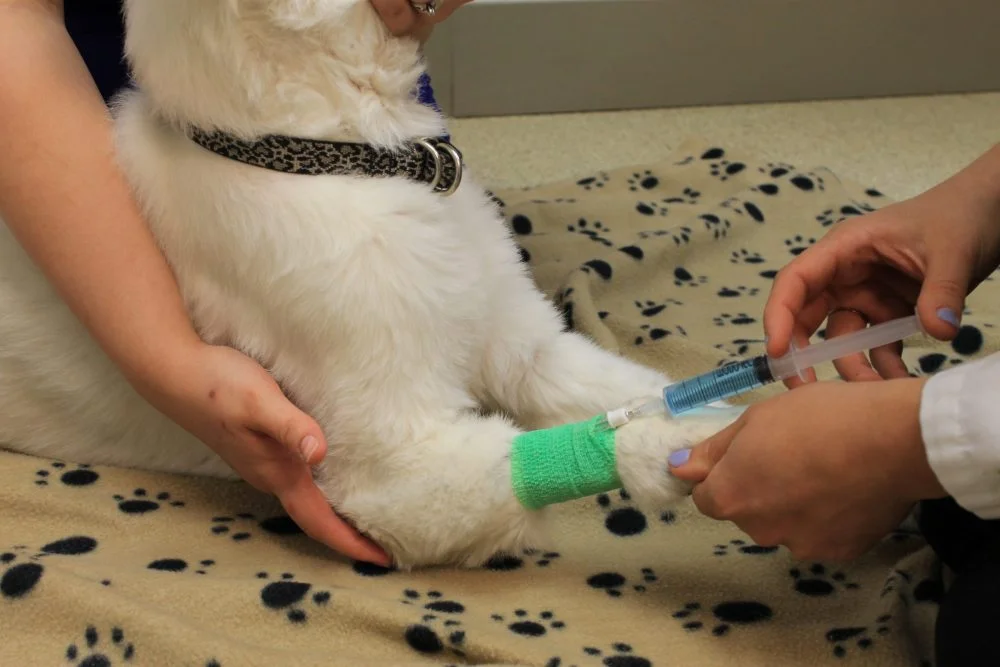
Having to say goodbye to a dog is really hard, and knowing when the right time is to do so can be difficult to decide.
This is an awful decision for anyone to have to make, but it is often the right thing to do when your dog is suffering or has a poor quality of life.
There are many different health conditions that dogs can have which could lead to making such a decision, and liver failure could be one of them.
Eventually, it can progress into something that is causing your dog pain and suffering, and the kind thing to do would be to have them out down.
If your dog has been diagnosed with liver failure, it can have a huge impact on their quality of life.
We understand how difficult of a time this is for you and your family, and we are here to help you to decide when the right time is to have your dog put to sleep.
We will also provide you with more information about liver failure to help you know what to expect.
What is Canine Liver Failure?
The liver is a really important organ that works to provide many different functions in the body. It has a large capacity and is capable of self-healing, which can provide some protection against disease and long-lasting damage.
The liver will help with digestion, converting nutrients, and storing vitamins and minerals. It will also help with metabolizing and storing various toxic compounds, which helps to detoxify the body.
However, this function can also cause issues, and we will explain more about this below.
Due to the fact that the liver will work to detoxify the body, it means that it is also susceptible to injury and damage. This exposure to toxins can cause liver damage, which will usually occur when over 75% of the liver has been damaged.
Some other things that can lead to liver disease are chronic inflammation, cancer, blood vessel abnormalities and immune disease.
What Are the Symptoms of Liver Failure in Dogs?
When it comes to liver failure in dogs, you should know that this is a condition that will cause both physical and mental symptoms. You may notice that your dog develops depression, lethargy, and strange behavior if they are suffering from liver failure.
There are some other signs that you can look out for too, which include:
- Blood clotting issues
- A change in the size of the liver
- Diarrhea
- Excessive urination and thirst
- Fever
- Fluid collection in the abdomen
- Jaundice (yellowing)
- Loss of appetite
- Neurological problems
- Seizures
- Vomiting
- Weight loss
The signs that liver failure presents can often be difficult to spot, as they are very similar symptoms to those that are presented by other conditions. However, if you do notice any of these signs, you should contact a vet immediately.
What Causes Canine Liver Failure?
There are lots of things that can cause liver failure in dogs, and you should be aware that dogs of all ages can be affected.
There are also some conditions that your dog could be genetically predisposed to, or born with, that can cause liver failure. As well as this, there are some breeds that are generally at a higher risk of developing liver failure.
Labrador Retrievers are a breed that are predisposed to copper storage disease, and Yorkshire Terriers are a breed that is predisposed to portosystemic shunts. These are liver disorders that can lead to liver failure over time.
Acquired liver disorders can be caused by:
- Bacterial and Viral infections
- Parasitic Infections
- Cancer
- Trauma
- Chronic Diseases, such as Cushing’s Disease & Diabetes
- Gallstones
- Ingestion of toxic substances
How is Canine Liver Failure Diagnosed?
Canine liver failure needs to be diagnosed by a vet, who will complete a blood test to find out if your dog is experiencing liver failure.
Some of these tests will include a complete blood count and chemistry profile and a bile acids test. This will give a good indication if your dog’s liver is able to metabolize proteins and get rid of toxins or not.
Your vet might also want to schedule an abdominal ultrasound for your dog, which will allow them to look at the abdomen and liver.
This will help to give them a better understanding of what the cause of the liver disease is, which could be things like cancer, infection, a gall bladder issue, or something entirely different.
Is There Any Treatment for Canine Liver Failure?
Unfortunately, there is no cure for liver failure once it has started, but the symptoms can be treated with anti-nausea medications, anti-diarrheal medications, and pain medications. If there is an underlying cause, this could be treated, but liver disease is not reversible.
There are special foods that you can get for dogs that have liver disease or liver failure, and these foods are specifically formulated to help to prevent the occurrence of neurologic signs in your dog.
These foods can be easily digested, and they can work to improve your dog’s quality of life. However, for dogs that are picky when it comes to their food, you may struggle to get them to eat it at all.
You can also choose to start your dog on liver disease supplements, which will help to slow down the progression of liver failure.
Some of these supplements will help to reduce oxidative damage to your dog’s liver cells, which is a side effect of the inflammation that is causing stress on the liver.

When Should You Euthanize a Dog With Liver Failure?
Making the decision to euthanize a dog with liver failure is not easy, and you will need to greatly consider your dog’s quality of life when making this decision.
As the disease progresses, your dog’s quality of life will start to deteriorate, and after time, the kindest thing to do can often be to say goodbye.
If your dog’s quality of life has deteriorated to the point where they are in pain and cannot function as they usually would, it might be time to start thinking about euthanasia.
If you are unsure if now is the right time, you can always speak to your vet, who will be happy to help provide guidance and resources.
Your vet will have a good understanding of liver failure, and how it has been affecting your dog. They will be able to confirm if what you are thinking is the right thing to do, but they may also suggest other alternatives if they think that your dog still has a good quality of life.
Ultimately, you will need to think about whether your dog is in pain, if they are able to work around like normal, and if they are suffering.
If your dog is suffering, then it might be time to say goodbye and prepare for the difficult decisions that need to be made next. Saying goodbye to your dog is never easy, but know that you are ending their suffering by doing so.
What is the Average Life Expectancy for Dogs With Liver Failure?
There are different stages of liver failure in dogs, and these stages will progress from the early stages, to the middle stages, to end-stage liver failure. The end stage will be fatal, and this is the end of the journey.
In some cases, liver failure can develop really slowly, and in other cases, it can progress really quickly. It all depends on the individual circumstances of your dog, and there is no way to say for sure how long each of these stages will take.
It is important to monitor the situation and keep an eye on your dog’s symptoms. These signs can often be a good indication of how your dog is doing.
In the early stages of liver failure, there will be abnormal inflammation, which is caused by an underlying issue. During this stage, your dog’s liver can still function, but in a more limited capacity.
Your dog might be more tired than usual and their appetite may change. They might also experience nausea and vomiting. If the condition is diagnosed early enough, it can be slowed down with treatment.
In the middle stages, you might start to notice that the symptoms are more obvious. Your dog could experience jaundice, which is a yellow coloration of the skin and gums, and even the whites of the eyes.
When the liver stops working, it stops producing albumin, which is a protein that works to keep fluid in your dog’s blood vessels and organs. Without albumin, the fluid can leak into the spaces around the organs and abdomen.
In end-stage liver failure, your dog might start to experience neurological issues, which can include things like depression and a change in mentality.
Some of the other neurological issues that can occur are blindness, dizziness, seizures, disorientation, pacing, and wandering. This occurs due to the fact that the liver can’t clear the body of toxins and metabolize proteins anymore.
What Can I Do to Help My Dog With Liver Failure?
If your dog has liver failure, there isn’t anything that you can do other than try your best to ensure that your dog is happy and comfortable.
There are things that can be done to manage the symptoms and pain that they are experiencing, but there is no cure for the condition.
As we have previously mentioned, there are special diets and supplements that could help to make a difference and slow down the progression of the disease, but there is no way to know how long it will take for the disease to deteriorate.
The amount of time that the process will take will vary from dog to dog, which makes it more difficult to predict the outcome of your own situation.
Ultimately, you are going to need to keep an eye on your dog, as some will have months, and others will have years. It is up to you to prevent their suffering by knowing when it has become too much for them.
Your vet will be able to advise you throughout this process, and you should take any advice that they have on board, as they will have helpful knowledge and experience.
You should do your best to give your dog lots of love and attention when they need it, but be sure to give them space when they need it too. The only thing that you can do now is to be there for them and comfort them in their time of need.
When the time comes to say goodbye, you can do so knowing that you did everything that you could to ensure that your dog is loved, cared for, and content.
